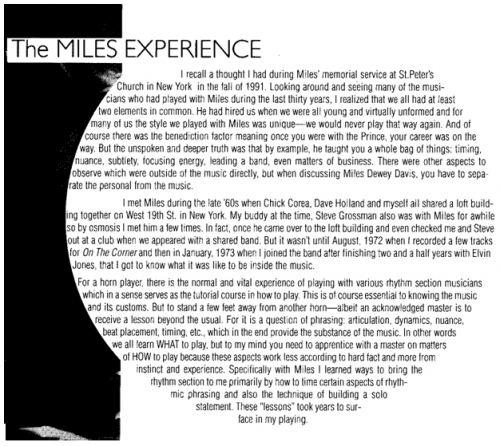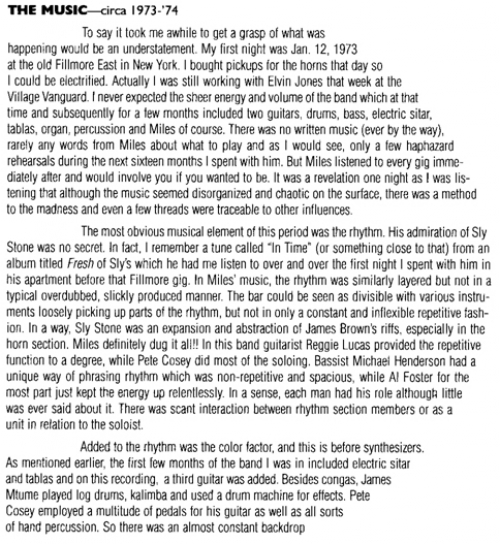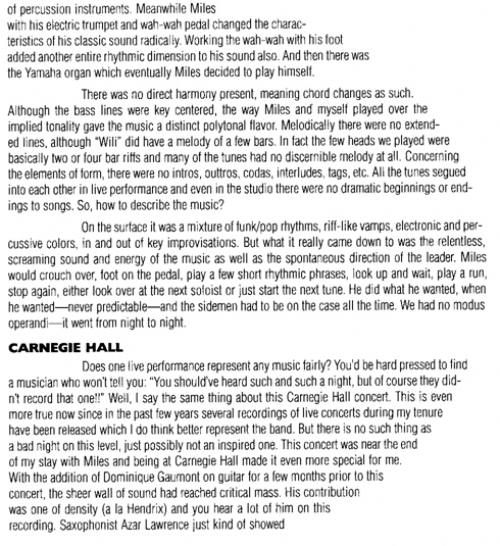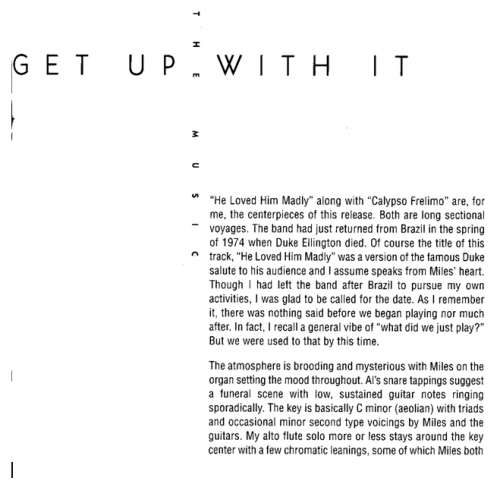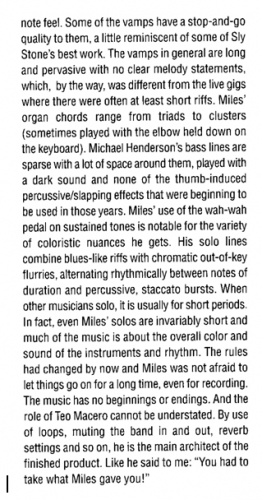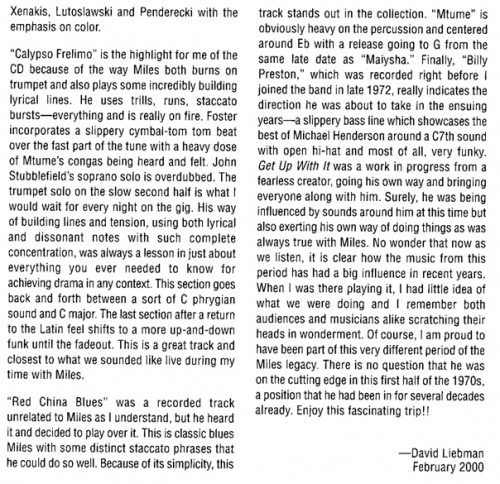by David Liebman
When a discussion about Miles Davis comes up, my thoughts vacillate between subjective and objective points of view. Being a jazz musician who has studied the legacy deeply, my knowledge of Miles’ music is vast as a result of his having been such a towering figure for forty years of jazz history in so many ways. On the other side, my feelings concerning the man are based on being part of his group and our interaction for a period in the 1970’s as well as sporadic contact until he died. It goes without saying that his effect upon me has been enormous. Therefore this overview of Miles Davis is both personal and analytical. I begin by recounting my first gig with the Prince of Darkness.
In the Band
When I found myself on the bandstand with Miles in January, 1973 for the first time I was figuratively speaking being split in half. At the time, I was a member of drummer Elvin Jones’ group for a year and a half. Elvin was very significant in my life years before I played with him in his position as a member of John Coltrane’s “Classic Quartet.” I saw the group live many times during the 1960’s in the clubs of New York as a teenager. It was Trane who directly inspired me to become serious about jazz and to recognize that this music (and art in general) went beyond entertainment and ordinary surface values. When I got the gig with Elvin in 1971 assuming saxophonist Joe Farrell’s chair it was beyond a dream come true. I was playing with one of the master drummers of all time in my idol’s position. Obviously this was a major event for me changing the course of my life.
I had informal contact with Miles through musicians like Chick Corea and Dave Holland, the three of us residing in the same Manhattan loft building during the early 70s (he actually came over for dinner one night); also through musical peers drummer Lenny White, conga player Don Alias and of course my saxophone bud from Elvin’s group, Steve Grossman who had already been with Miles for a brief period. In the summer of 1972 I participated in one of the “On The Corner” recording dates. At the end of the session Miles passed by me in the control room and in that infamous raspy voice said: “Join my band!” I couldn’t tell if he was serious or not, but in any case I replied to the effect that I was with Elvin and wouldn’t leave him, bringing to an end our brief exchange.
A few months later I was playing with Elvin at the Village Vanguard, our regular gig in New York. Miles came down and hung out a talking to me about his music with great enthusiasm (he had just released “In Concert”) and urging me to join his group. Elvin was muttering something like: “What’s he doing here?” By the end of the second night when he returned again I told him it was up to “Emperor” Jones (as Elvin was known). Around four in the morning Miles called to say that Elvin agreed meaning I was to play with Miles that coming Friday night at the famous Fillmore East Theater early in the evening (which re-opened for that one night and then closed forever), return to the Vanguard to finish the engagement with Elvin and the next week in Boston at the Jazz Workshop. After that I would become the saxophonist in the Miles Davis Group. To finish this incredible tale, the next night when I showed up at the Vanguard, Elvin hugged me and said: “If Miles Davis wants you, you have to go.” End of story!
So on Friday night, Jan 12, 1973 I got on the bandstand with Miles Davis at the Fillmore East, all plugged in (my horns-tenor, soprano and flute were all drilled to accommodate microphone pickups that day for amplification), not knowing anyone in the band except tablaist Badal Roy who was with me was on the “My Goals Beyond” recording with John McLaughlin in 1972 and drummer Al Foster from jam sessions in my loft. That I had no idea what I played or what was happening on the bandstand that night would be an understatement. The energy, volume and sheer textural density was overwhelming. After the gig I returned to the Vanguard in time for the remainder of the first set. It felt like I had gone from the future back in time; from the 21st to the 20th century on the most significant night of my professional life. I was to become part of history playing in the same position as Coltrane, Bird, Wayne Shorter and others alongside the most important musician of the past decades whose sidemen by and large became significant forces on their own. That was the “baggage” which was undeniably part and parcel of being in the saxophone chair with Miles Davis.
For the first few months before he cut the band down, the instrumentation was tablas, electric sitar, guitar, organ, drums, congas, bass, myself and Miles. Playing mostly concerts and relatively short sets it took me months to truly “hear” what was happening and what my place was in the music. You had to figure out what to do on your own. There were no written charts and Miles said almost nothing to me or anyone else from what I could observe about the music. What we played has been well documented on tape and many live bootleg recordings that are available including on U Tube. It should be noted that with this group live performance was the main event. In fact, in some ways one could say that hearing any of Miles’ groups live was the best way to understand the essence of what was going on musically throughout his entire career, not withstanding some landmark studio recordings. With the level of musicians Miles had in his groups throughout history the live experience was always amazing.
As I point out several times in this article Miles was the quintessence of a true jazz musician in that he trusted, invested in and savored the moment meaning spontaneity was everything. From my standpoint this was the saving grace during this period since the actual content of the music was not something I was impressed with, sounding to me disorganized, chaotic and VERY loud. To be honest and risking sounding a bit pompous, though I was grateful and honored to be standing next to a legend and all that implied, I couldn’t help but think about how wonderful it would’ve been to play some of the challenging and sophisticated music from Miles’ past, particularly the “Miles Smiles” quintet-anything but this cacophony!! However, I must admit that hearing the music over the decades, what we played sounds better than it did at the time. Maybe this kind of retro-appreciation is a natural by-product of the passage of time or just me, but slowly I could hear what Miles was trying to accomplish. Though the artistic and aesthetic merits can be analyzed ad infinitum there was no doubt that he had a concept in his head.
The Music
There are some artists in any field who because of their prolific nature over an extended period of time, any analysis of their work necessitates it be described in terms of various periods. Painters like Monet, Van Gogh and Picasso are examples of this while in jazz there are Coltrane, Wayne Shorter and Miles to name a few who clearly demonstrate this point.
With Miles it begins with the Charlie Parker/Birth of the Cool bebop era in the 1940’s followed by the various quintets during the 50’s and 60’s which includes the Gil Evans collaborations. All of these stages are replete with their own specific musical attributes and stylistic characteristics. Most important for the purposes of this writing there is the seminal dividing line in the Miles Davis legacy occurring in the late 1960’s simultaneously on several musical fronts leading to the “electric” period:
-shift from acoustic to electric setting especially the use of electric bass rather than upright
-concept of jazz-rock based on ostinato bass lines which meant at the time jazz-like soloing played over a rock type rhythmic feel
-choices of sidemen who were not jazz musicians as such coming from other styles such as bassist Michael Henderson, drummer Ndugu Chancellor, etc.
-use of percussion and “world music” instruments (Airto, Badal Roy, Mtume)
-less or no “tune oriented” compositions replaced by ongoing vamps with the consequent effect of more limited harmonic movement
Even in this so-called electric period which remained Miles’ modus operandi for the remainder of his life there are dividing lines. For example between the early recordings “Filles De Kilimanjaro/Miles In The Sky/Silent Way” which retain a jazz sensibility to the cacophonous “Bitches Brew” and rock-jazz “Live at the Fillmore” with Jack DeJonette, Chick Corea, etc., (incredibly a band that was not too well documented in the studio); as well there are stylistic differences between the “Live-Evil” band with Keith Jarrett, John McLaughlin and the “Dark Magus/ On The Corner/Get Up With It” groups that I was part of; then there are the “Agartha/Pangea” live recordings which delve even further into sound and color; finally the 1980’s decade where the direction was towards a more pop oriented sound.
The period when I was with Miles (1973-74) continuing through 1975 when he took a “sabbatical” can be seen as an expansion of the musical elements described above evolving towards more and more abstraction as time went on. ( In my opinion when Miles returned to performing in the 1980’s many of these innovative musical aspects were watered down resulting in a less distinctive and more generic style, albeit more palatable to a new generation of listeners. Interestingly though, Miles’ playing itself still remained brilliant at times. In any case this is in itself a separate and controversial topic on its own.) Some of the musical developments during my period with Miles were further developments of the earlier innovations, emphasizing the incredible speed of change that was occurring during this period.
– increased use of electronics resulting in a thicker and varied textural density; wa-wa pedal on the trumpet; use of the Yamaha organ; chorus and delay on my saxophone; Mtume’s drum machine, Pete Cosey’s percussion instruments
– more “accidental” harmonic dissonance; two and for a period three guitarists playing together (Reggie Lucas, Pete Cosey, Dominique Gaumont); non- tonal organ chords played by Miles
– even less use of formal compositional devices, forms and melodic statements with instead an almost total reliance on simple and extended vamps (in terms of duration during a typical set) as well as a continuation of Miles’ penchant for ongoing segues between tunes
– increased rock/ funk underpinning in which rhythms overlapped and were spread out between various rhythm section instruments (Sly Stone concept)
– solos that were not so much developed as they were episodic or short vignettes
Miles’ playing, though fundamentally retaining the main ingredients of his basic style changed in some dramatic ways. The use of the wa-wa pedal and pickup on the trumpet meant that the very unique and incredibly individual trademark sound that Miles Davis had on his horn since time immemorial was transformed, arguably gaining something unique in the process. Whether it was the effect of how he heard himself through the pedal or other contributing factors his playing became even more rhythmically pronounced as well as very focused in the middle of the beat. (The best jazz musicians treat the pulse with a loose and flexible attitude pushing and pulling the beat at will. I have always thought that Miles’ sense of pulse was among the most accurate of any jazz musician in history.) His “jabbing” rhythmic style (not unlike boxing, something Miles was very into both as a participant and observer) was interspersed with flurries of notes consisting of indistinguishable pitch runs and occasional long tones thrown in. All of these stylistic mannerisms were played in a dry sonic context without reverb or delay heightening the stark nature of Miles’ rhythmical approach even more. His note choices ranged from very diatonic/in the key lyrical phrases combined with blues scale motifs to completely out of tonality asides. Of course whatever came out of his horn still retained a melodic contour with on occasion nursery-rhyme type melodies thrown into the mix. All of this as always in Miles Davis’ case was executed with élan, bravura and a unique sense of space and timing which remain historically the most distinct aspects of his overall style. There is no doubt in my mind that Miles was thinking within a certain set of parameters concerning his trumpet playing during this period.
Finally there is the way he framed all of this as a bandleader of the various groups during this electric period. Prior years had seen Miles play a solo, leave the stage, returning often in the middle of someone else’s statement to start up again (usually the piano solo). During my time he was an ever present force on stage, something which had its effect on the sidemen. Not only did he not leave the stage but he would stand with his back to the audience, staring at all of us through gigantic dark sunglasses nonetheless!! Marking the beat physically with his body, nodding in the direction of someone to solo, he might unexpectedly cue the band to execute uneven “stop” time episodes in the midst of a phrase, a traditional device from older jazz styles. And there was the Yamaha organ which was a kind of precursor to the whole keyboard technology about to be unleashed in the next few years. Miles would splash down clusters and triads at will thereby orchestrating the live performance even further. As mentioned above, vamps and ostinato bass figures melded together and overlapped. Though there was a loose format to our live performances there was little predictability meaning the music could change drastically from night to night. To sum it up, Miles was a real and looming force on the bandstand whether he was actually playing or not.
The Unspoken – Beyond the Music
It is commonly accepted that among the arts music is the hardest to describe in real and measurable terms. We cannot hold music in our hands, not withstanding a manuscript which is meaningless until it is heard. The effect of music can barely be quantified in universal terms because of its subjective nature. Among musicians themselves generalizations about music are usually suspect and as the saying goes one cannot account for taste. We try to assess and describe music verbally in our various roles as interested listeners, musicians, teachers and journalists, but in the final analysis what sounds like something to one person may or may not have any bearing on another listener’s opinions. (Just go to any web site where people comment on a U Tube performance for example.)Yet we know and feel in our hearts and souls that there is something spiritual, universal and meaningful in great music which is valuable to recognize. The same can be said when you stand next to greatness, especially in a live performing situation where everything is focused on vibration, nuance and present time. These fleeting moments and the subtle lessons incurred constitute the unspoken and implied elements of any art, but even more so for those mediums in which performance IS the form itself (theater and dance as well as music). I had a golden opportunity to observe greatness in action and learn from it, only a few feet away from me on a nightly basis.
When Miles went on stage there was no past or future. As mentioned, it was all about present time, the essence of true improvisation and what most of us as jazz musicians strive for daily when playing. I have recounted to students and interviewers how concentrated Miles became in the moments before we hit the bandstand. Quiet, subdued and seemingly deep in thought, the whole band could sense his vibe before we walked out. It wasn’t so much dramatic as it was penetrating and you could feel that serious business was about to commence. (I felt the same with Elvin Jones, but in his case it would begin when the stick hit the cymbal.) For me, it was a lesson in owning and trusting the moment, two intangible aspects of playing that I have tried to absorb into my own musical personality.
Another point concerning Miles’ playing and bandstand persona was his complete confidence in whatever gesture he made whether in his own playing or something having to do with directing the band. One never felt a second of doubt. This meant that anyone within playing range could by osmosis, transfer Miles’ strong sense of conviction and self in their own playing. I certainly doubted myself to some degree at this stage of my life, but with his energy going on in such close proximity there was no chance to think about it, something that is particularly true in the recording situation which has its own and unique set of variables differing from the live arena. You realize that when the light is green anything you play may be heard anywhere, anytime and forever-the ultimate judgment day! This posterity aspect of recording can easily develop into a nerve racking experience depending upon one’s personality. But once again with Miles Davis you just had to concentrate and be on his case-watching, listening and ready to jump into the fray when called upon.
Learning is a long term process. One doesn’t just cognize an idea or concept and expect the light to go on the next day. This is especially true for music where it takes a certain amount of time for the instincts and mind, body and ear to get it all together in some consistent, well balanced package. We learn something new using all of these techniques at hand from the technical to the emotional to the intellectual, employing different and appropriate aspects of these learning tools in varying proportions and sequences depending upon one’s learning methodology combined with the scope of the material in question. The goal remains the same: to unify the mind, body and spirit in order to make a meaningful artistic statement. The lessons I learned from being around Miles Davis took a decade or more to firmly take root. This pertains to everything from instrumental grafts that I have incorporated on the soprano saxophone gathered from observing Miles’ trumpet style, especially in the rhythmic realm; the being in the moment aspects I have alluded to; focusing the other musician’s energy as a function of leading a band; and gaining the confidence necessary to enable musical events to occur with spontaneity and regularity. In the 1980’s I would find myself thinking of Miles in the middle of a solo which might alter or inspire a fresh direction as needed. It still happens on occasion, but obviously less so as that period of my life recedes with the passage of time.
Personal Reflections
Without going into too much detail, suffice to say that Miles’ public and personal demeanor were in some ways similar but in other aspects vastly different. To my mind, it appeared that Miles’ basic shyness led to a desire to be left alone. Miles was more than a jazz trumpet player; he was a symbol of many things to different people and unless he limited access he would’ve never been left alone to think about music. This apparently contributed to the popular image of Miles as aloof or at times mean spirited. Though he had various addictions, illnesses, distractions, etc., there was no doubt in my mind that music always came first.
Miles was a macho type of person and respected that kind of persona. Speaking for myself there is naturally, as a product of upbringing and environment, a “New York aspect” to my personality which he seemed to empathize with. As well, because of childhood polio and its subsequent effects on my leg, I think Miles respected my energy and persistence in spite of any handicap. This was highlighted during my time with him because of increasing problems he was having with his own legs as a result of a car accident. I am not implying that we were buddies in the typical sense but there was some good and positive rapport for sure. (Apparently, he trusted me to recommend saxophonist Bill Evans when he began to play again in the early 80’s.) Personally, we got along quite well and spent time hanging out on the road since for the most part he didn’t like to be alone. He was well aware that I (and drummer Al Foster) were “jazzers” who knew in detail about his musical past which seemed to contribute towards a particular bond. In any case, there were numerous examples of his generosity and personable behavior, for example when he called me offering financial help during some hard times I was going through nearly ten years after I left his employ. Of course there were rough episodes to be sure, especially when his natural penchant for drama (an aspect of his playing which was undeniable), combined with the need to relieve a feeling of “ennui” or general boredom with life during this period, could at times lead to some “problems” to say the least. Also his health was fragile and he was at times heavily medicated during this time.
In the final analysis, having performed and traveled with Miles Davis was a major contributing factor not only for my career, but towards molding who I am both musically and as a human being. Though I didn’t know Coltrane personally it appears that the two of them had in common their love and respect for the serious work of creating highly sophisticated and eternal music.
As Miles once reminded me in dramatic fashion, being with him made me in some ways part of the jazz blood line back to Louis Armstrong. Consequently, I have tried to maintain the integrity and honesty which I observed and felt through my experiences with Miles and Elvin Jones. I had the best possible training a person could ask for-a real time apprenticeship with masters of the art-the Prince and the Emperor-a privilege and honor that I have gladly accepted with a concomitant sense of responsibility during my allotted time on this planet. For that opportunity I am eternally grateful.
Stroudsburg, PA USA
Fall/Winter 2008-09





